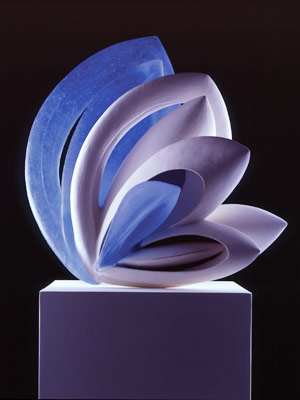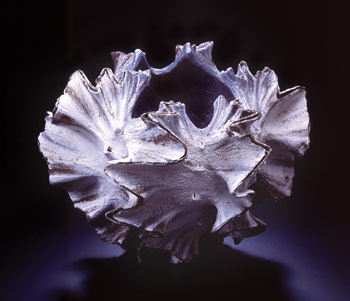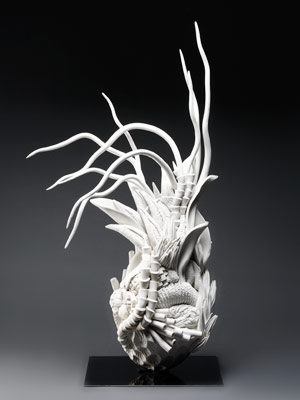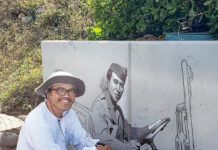Story by Rick Chatenever

Twenty-five Soaring Voices will arrive at the Maui Arts & Cultural Center in October — not to be heard, but seen.
The title doesn’t refer to a musical production in Castle Theater, but to a museum-level touring exhibit in Schaefer International Gallery featuring twenty-five of Japan’s leading ceramic artists.
All the creations are by women, each an accomplished leader, professor or trailblazer in new forms of this ancient art. Soaring Voices: Recent Ceramics by Women from Japan bursts with life.
“What I saw in these women’s work was power, strength, sprouting energy, as if they had been trapped or hidden under the earth until then,” says exhibit curator Maya Nishi.
The exhibit, concluding a ten-museum tour at the MACC, showcases artists ranging in age from their twenties to their eighties. Their contributions to Japan’s proud, millennia-spanning ceramic tradition have everything to do with breaking molds. These women can turn clay into something organic, like plants or human body parts; or incredibly thin, like paper. They can infuse it with an illusion of weightlessness, seemingly defying gravity. Others temper their raw material — humble earth — into colors and concepts it’s never captured before.
“Technically they have wonderful skills,” says Nishi, “and their creativity is another thing.”
In 1994, Nishi wrote a magazine article about Japanese women making new inroads in this field. Her research planted the seeds for the exhibit, although it would take more than a decade to come to fruition. While Soaring Voices is very much about creative breakthroughs, at its core is an even deeper sea change in cultural values and assumptions.

After centuries of their maternal ancestors’ toiling in the shadows of the family workroom or as anonymous cogs in pottery factories, the women of Soaring Voices are waking to the new sensation of seeing themselves recognized as ceramic artists.
“Women have always been involved in the production of ceramics in Japan,” writes Smithsonian Institution Curator for Ceramics Louise Allison Cort in the exhibit catalog.
Their roles predated the arrival of the potter’s wheel in the fifth century; they created hand-pinched utilitarian kitchenware and dishes for more than a millennium. By the nineteenth century, women were revolving the wheel for the male potters, complementing the men’s harder physical tasks with more dexterous activities, like preparing glazes and adding lugs and spouts to teapots.
In the workshops of the late-nineteenth and twentieth centuries, women were the nameless artists adorning 500 to 600 teapots a day with minimal brushstrokes: “She draws out one or two diagonal lines. A mountain rises up,” wrote the late ceramic master Kawai Kanjiro, observing a woman working in Koyama village in Shigaraki. “In the space between she draws two or three wedges. Boats under sail.”

That all began to change in postwar Japan. Universities began accepting more women ceramics students. Clay was more readily available throughout the country. Gas and electric kilns were not as physically demanding as traditional wood-fired ones. The Women’s Association of Ceramic Art in Japan formed in 1959, encouraging its members to explore and push boundaries, as they were becoming emboldened to add their personal signatures
stylistically.
Ironically, the very forces that subjugated Japan’s women in ceramics were the pathways to their creativity.
“Men tend to follow the restrictions of the tradition,” Nishi explains, speaking by phone from her office in Tokyo. “But women didn’t have any restrictions, because they were excluded from the traditional ceramics world. Because women were outside [the restrictions of] the traditional ceramics makers, they could make anything. I think women’s works are more expressions of themselves.”
Soaring Voices was the perfect title for the exhibit, says Nishi. As its artists stake out new territory for themselves in this previously male-dominated realm, their voices “are becoming louder, clearer.”
The title also came about after a museum director she worked with didn’t want to include
the word “women” in the title.
“He was stubborn,” says Nishi with a laugh. The exhibit serves notice on that sort of thinking.
It’s no coincidence that “discussions with clay” is a recurrent theme in the descriptions Soaring Voices’ artists give of their work. Dynamic tension abounds. From the botanical roots, stems and flowers that inspired Kyoko Tokumaru’s Hatsuga – Germination; to the ashes of pine, chestnut and oak that Kiyoko Koyama uses instead of glazes during weeks of firing; physics and other laws and uncertainties of nature are collaborators in rendering a finished work.
Gravity shifts the delicate balance of parallel planes in Fuku Fukumoto’s Moon Shadow. Other masters turn clay into paper-thin pages to be silkscreened with text or pictures. Kimiyo Mishima creates comic books she calls “breakable printed matter.” Takako Araki draws pages from the Bible with stone and sand.
The artists live all over Japan, but many will meet for the first time on Maui, where a week of gala receptions, symposia and lecture-demonstrations will accompany the exhibit. Some of the works will be for sale; local gallery visitors may find themselves mingling with leading figures in the art worlds of Japan and the U.S., who are expected to attend.
From the outset, Maui represented a bridge to bring Soaring Voices to the West. Neida Bangerter, director of the Schaefer International Gallery, recalls the first meeting in 2005, when Nishi visited from Japan to see if there was interest.
“She had seen the gallery before and loved the space,” Bangerter says. “She was looking to us for a commitment.”
“I thought Maui was the perfect place to show the work,” recalls Nishi. “Hawaii is geographically between the United States and Japan. Many Japanese went to work in Hawaii and made many settlements there. It really is a place where East meets West.”
Commitment did come from Maui as well as from Sacramento’s Crocker Art Museum, although when the tour finally began in 2009, Schaefer Gallery went from its first to its last stop.
For Bangerter, “It’s the biggest exhibit I’ve ever done sitting in this chair. We’re not a museum with collections, but a museum space. This is putting us on the map.
“This isn’t pottery, it’s sculpture.”
Soaring Voices: Recent Ceramics by Women from Japan was organized by the Shigaraki Ceramic Cultural Park, Shiga and hus-10, Inc., Tokyo. Tour organized by International Arts & Artists, Washington, D.C. Support for the exhibit on Maui comes in part from the Hawaii Tourism Authority, County of Maui Office of Economic Development, and the Fairmont Kea Lani Maui.





